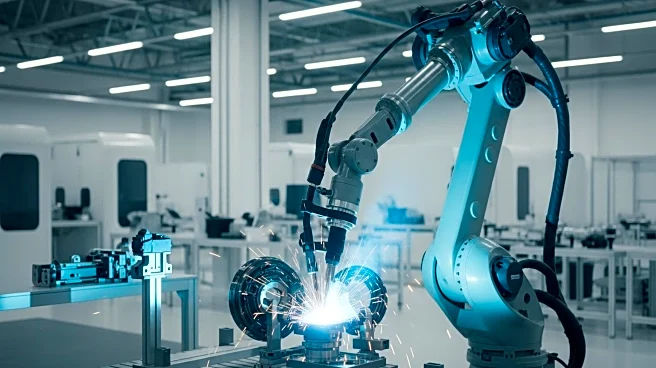What's Happening?
Researchers at Virginia Tech, led by Associate Professor Prahalada Rao, have developed a method to improve metal manufacturing using AI-powered wire-arc additive manufacturing, essentially 3D welding. This technique allows for real-time detection and correction of flaws during the manufacturing process, ensuring parts are ready for use immediately after production. The study, published in the journal Materials and Design, highlights the potential of AI to revolutionize the production of complex components for submarines and aircraft, traditionally reliant on slow and resource-intensive machining methods. The AI system monitors the 'melt pool' of hot metal, learning to identify defects and signal adjustments before they spread, thus reducing waste and production time.
Why It's Important?
The integration of AI into wire-arc additive manufacturing represents a significant advancement in the defense and aerospace industries, which have historically depended on small machine shops for critical components. These traditional methods are slow and often result in wasted resources due to undetected flaws. By employing AI, manufacturers can produce parts faster and with greater precision, potentially reducing costs and increasing efficiency. This development could lead to a shift in manufacturing practices, with AI-driven processes becoming the norm, thereby addressing the challenges posed by a shrinking skilled workforce and the closure of many machine shops post-Cold War.
What's Next?
The research team at Virginia Tech is part of a larger initiative to advance manufacturing education and practices. They are utilizing facilities like the Learning Factory to train students on industry-standard machines, preparing them for the future of manufacturing. As AI technology continues to evolve, it is expected that more industries will adopt similar methods, leading to broader applications and further innovations in manufacturing processes. The success of this AI-powered approach could prompt other sectors to explore similar technologies, potentially transforming manufacturing across various fields.
Beyond the Headlines
The use of AI in manufacturing not only enhances efficiency but also raises questions about the future of skilled labor in the industry. As AI systems become more prevalent, there may be a shift in the types of skills required, with a greater emphasis on AI and machine learning expertise. This could lead to changes in educational curricula and workforce training programs, ensuring that future workers are equipped to handle advanced manufacturing technologies. Additionally, the environmental impact of reduced waste and resource use in manufacturing processes could contribute to more sustainable practices.












